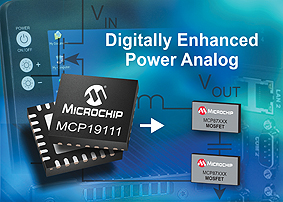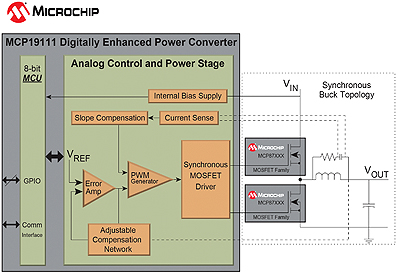
The latest mixed-signal controllers combine the best of both the analogue and digital power-conversion worlds, explains Stephen Stella, of Microchip Technology Inc.
Since the introduction of digital power conversion designers have had a clear choice between using analogue or digital for their designs. Each approach has its own distinct benefits as well as drawbacks, but the development of mixed-signal or hybrid controllers is making it possible for designers to combine the best of both power-conversion worlds.
Analogue for performance
The advantage of analogue power conversion is that it offers very efficient control, whilst the down-side is that it gives designers very little flexibility. Once the performance tradeoffs have been evaluated for each design, the chosen optimisation path is applied across the whole load profile and across the full power-conversion operating range.
Using this single level of optimisation across a design’s full power-conversion spectrum has been the industry standard for many years because, whilst it is inherently inflexible, it does deliver efficient control. However, recent government regulations, and the increasing expectations of end-users, are driving designers to achieve greater efficiency. This is pushing analogue power conversion to the limit of its efficiency and persuading many designers to make the change to digital power conversion.
Digital for flexibility
The main benefit of digital power conversion is that it offers the flexibility that analogue conversion lacks. It replaces one level of power-conversion optimisation with multi-point optimisation. It also provides the ability to communicate with the system, enabling power conversion to become part of the overall optimisation of the system’s long-term performance.
The disadvantage of digital power conversion is that this flexibility comes at the price. The digital approach increases system complexity because the analogue feedback from the system needs to be digitised before it can be used for power management. This means adding an analogue-to-digital converter, and also a high-speed microcontroller or digital signal processor to provide the processing power to achieve digital control.
The speed of the A/D conversion and the computational speed of the MCU/DSP determines the bandwidth of the digital control loop. So, if a design needs more bandwidth, it needs faster and more costly ADCs and MCUs.
Another factor is that digital-control techniques are very different to the techniques needed for analogue control. Making the switch from analogue to digital requires significant investment in the skills, resources, tools and processes required for digital design and software engineering. This investment can be a significant barrier to some companies.
The combined strength of hybrid controllers
Component manufacturers have addressed this dilemma by eliminating the choice between analogue and digital design with mixed-signal, or hybrid, controllers. Combining the strengths of both analogue and digital power conversion, hybrid controllers offset the weaknesses which are inherent in each approach. This enables designers to achieve the

flexibility of a digital solution with the efficiency, load regulation and transient response of analogue power conversion. It also eliminates the need for designers to learn specialised skills or invest in new design resources and processes. Figure 1 shows the block diagram of Microchip’s MCP19111. This hybrid controller integrates a peak current-mode analogue controller with a small, 8-bit microcontroller. By performing power regulation in the analogue domain, the MCP19111’s integrated 8-bit microcontroller provides enough processing power to monitor and adjust the performance of the analogue controller.
Also on-board the MCP19111 are on-chip power MOSFET drivers and a mid-voltage LDO. This high level of integration enables the MCP19111 to significantly reduce the number of external components that are needed for power conversion whilst introducing a degree of flexibility that is not possible with analogue-only power conversion. A very wide operating voltage range of 4.5 to 32V operating range provides even more flexibility for the designer.
The introduction of hybrid or mixed-signal power conversion controllers offers designers the combination of the performance of analogue conversion, with the flexibility of digital control, at a cost that makes it accessible to a very wide range of applications. Whilst some designers will continue to make the choice and accept the limitations of analogue-only or digital-only power conversion, others will combine the best of both worlds by choosing the performance and flexibility of hybrid controllers.
www.microchip.com


